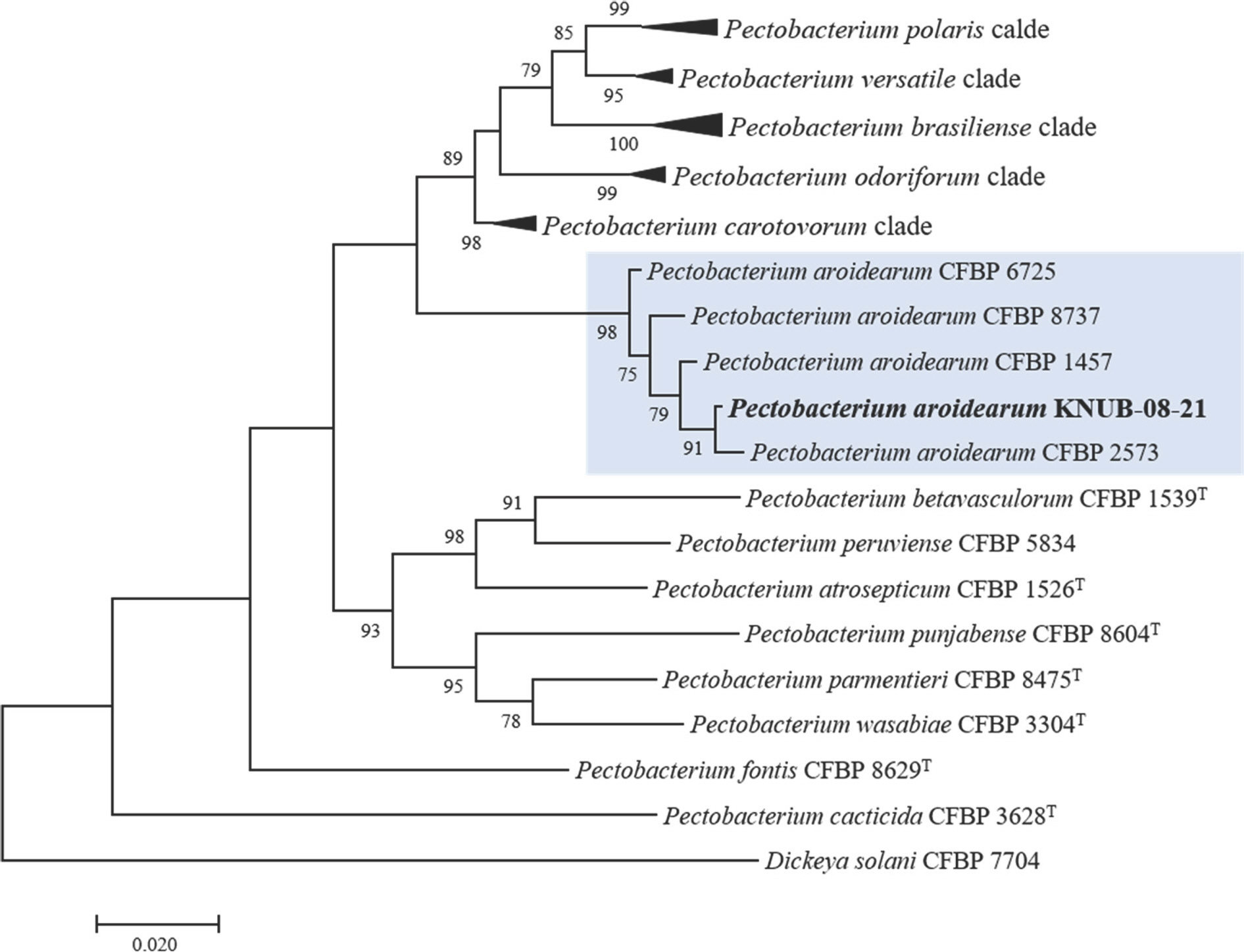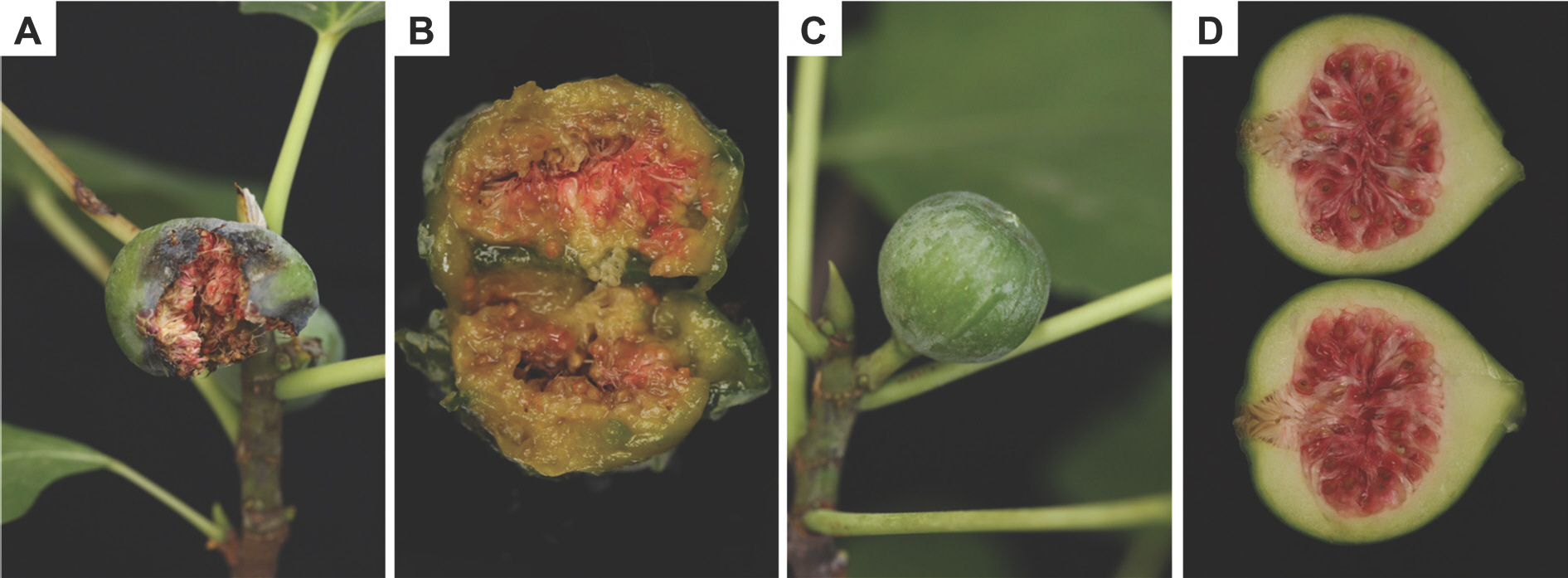Adeolu, M., Alnajar, S., Naushad, S. and Gupta, R. S. 2016. Genome-based phylogeny and taxonomy of the ‘
Enterobacteriales’: proposal for
Enterobacterales ord. nov. divided into the families
Enterobacteriaceae, Erwiniaceae fam. nov.,
Pectobacteriaceae fam. nov.,
Yersiniaceae fam. nov.,
Hafniaceae fam. nov.,
Morganellaceae fam. nov., and
Budviciaceae fam. nov.
Int. J. Syst. Evol. Microbiol. 66: 5575-5599.


Badgujar, S. B., Patel, V. V., Bandivdekar, A. H. and Mahajan, R. T. 2014. Traditional uses, phytochemistry and pharmacology of
Ficus carica: a review.
Pharm. Biol. 52: 1487-1503.


Bouzar, H. and Jones, J. B. 2001.
Agrobacterium larrymoorei sp. nov., a pathogen isolated from aerial tumours of
Ficus benjamina.
Int. J. Syst. Evol. Microbiol. 51: 1023-1026.


Campoverde, E. V. and Palmateer, A. J. 2011. A severe outbreak of Xanthomonas on Ficus elastica in South Florida. Proc. Fla. State Hort. Soc. 124: 321-322.
Charkowski, A. O. 2018. The changing face of bacterial soft-rot diseases.
Annu. Rev. Phytopathol. 56: 269-288.


Chen, L. R., Lin, P. R. and Huang, C. J. 2020. First report of
Pectobacterium aroidearum causing soft rot disease of white calla lily in Taiwan.
Plant Dis. 104: 563.

Elboutahiri, N., Thami-Alami, I., Zaïd, E. and Udupa, S. M. 2009. Genotypic characterization of indigenous Sinorhizobium meliloti and Rhizobium sullae by rep-PCR, RAPD and ARDRA analyses. Afr. J. Biotechnol. 8: 979-985.
Li, L., Yuan, L., Zhao, Y., Shi, Y., Chai, A., Xie, X. et al. 2022. Emergence of bacterial soft rot in calla lily caused by
Pectobacterium aroidearum in China.
Crop Prot. 152: 105854.

Ma, B., Hibbing, M. E., Kim, H. S., Reedy, R. M., Yedidia, I., Breuer, J. et al. 2007. The host range and molecular phylogenies of the soft rot enterobacterial genera
Pectobacterium and
Dickeya.
Phytopathology 97: 1150-1163.

Mikiciński, A., Warabieda, M., Nowak, J. S. and Puławska, J. 2023. First report on
Pectobacterium aroidearum, a new pathogen causing soft rot on alocasia (
Alocasia amazonica) in Poland.
J. Plant Pathol. 105: 1169-1170.


Moraes, A. J. G., Souza, E. B., Mariano, R. L. R., Silva, A. M. F., Lima, N. B., Peixoto, A. R. et al. 2017. First report of
Pectobacterium aroidearum and
Pectobacterium carotovorum subsp.
brasiliensis causing soft rot of
Cucurbita pepo in Brazil.
Plant Dis. 101: 379-380.

Mousavi, S. A., Hasanzadeh, N. and Abdollahi, P. 2020. Identification and characterization of bacterial agents causing moderate damage and souring of the fig fruits.
J. Plant Pathol. Microbiol. 11: 514.


Nabhan, S., de Boer, S. H., Maiss, E. and Wydra, K. 2013.
Pectobacterium aroidearum sp. nov., a soft rot pathogen with preference for monocotyledonous plants.
Int. J. Syst. Evol. Microbiol. 63: 2520-2525.


Portier, P., Pédron, J., Taghouti, G., Dutrieux, C. and Barny, M. A. 2020. Updated taxonomy of
Pectobacterium genus in the CIRM-CFBP bacterial collection: when newly described species reveal “old” endemic population.
Microorganisms 8: 1441.



Portier, P., Pédron, J., Taghouti, G., Fischer-Le Saux, M., Caullireau, E., Bertrand, C. et al. 2019. Elevation of
Pectobacterium carotovorum subsp.
odoriferum to species level as
Pectobacterium odoriferum sp. nov., proposal of
Pectobacterium brasiliense sp. nov. and
Pectobacterium actinidiae sp. nov., emended description of
Pectobacterium carotovorum and description of
Pectobacterium versatile sp. nov., isolated from streams and symptoms on di-verse plants.
Int. J. Syst. Evol. Microbiol. 69: 3207-3216.


Singh, D., Singh, B. and Goel, R. K. 2011. Traditional uses, phytochemistry and pharmacology of
Ficus religiosa: a review.
J. Ethnopharmacol. 134: 565-583.


Sławiak, M., van Beckhoven, J. R. C. M., Speksnijder, A. G. C. L., Cza-jkowski, R., Grabe, G. and van der Wolf, J. M. 2009. Biochemical and genetical analysis reveal a new clade of biovar 3
Dickeya spp. strains isolated from potato in Europe.
Eur. J. Plant Pathol. 125: 245-261.


Sun, M., Liu, H., Huang, J., Peng, J., Fei, F., Zhang, Y. et al. 2019. A loop-mediated isothermal amplification assay for rapid detection of
Pectobacterium aroidearum that causes soft rot in Kon-jac.
Int. J. Mol. Sci. 20: 1937.



Waleron, M., Waleron, K., Podhajska, A. J. and Łojkowska, E. 2002. Genotyping of bacteria belonging to the former
Erwinia genus by PCR-RFLP analysis of a
recA gene fragment.
Microbiology 148: 583-595.


Wei, H. Y., Yang, M., Pei, W. H., Wei, W., Huang, F. Y., Liu, J. N. et al. 2020. First report of
Pectobacterium aroidearum causing soft rot of
Amorphophallus konjac in China.
Plant Dis. 104: 969.

Xie, H., Li, X. Y., Ma, Y. L. and Tian, Y. 2018. First report of
Pectobacterium aroidearum causing soft rot of Chinese cabbage in China.
Plant Dis. 102: 674.

Xu, P. D., Wei, D. D., Li, Z. P., Qin, C. X., Li, X., Lin, C. H. et al. 2020. First report of bacterial soft rot on
Syngonium podophyllum caused by
Pectobacterium aroidearum in China.
Plant Dis. 104: 2720-2721.








 PDF Links
PDF Links PubReader
PubReader ePub Link
ePub Link Full text via DOI
Full text via DOI Download Citation
Download Citation Print
Print






